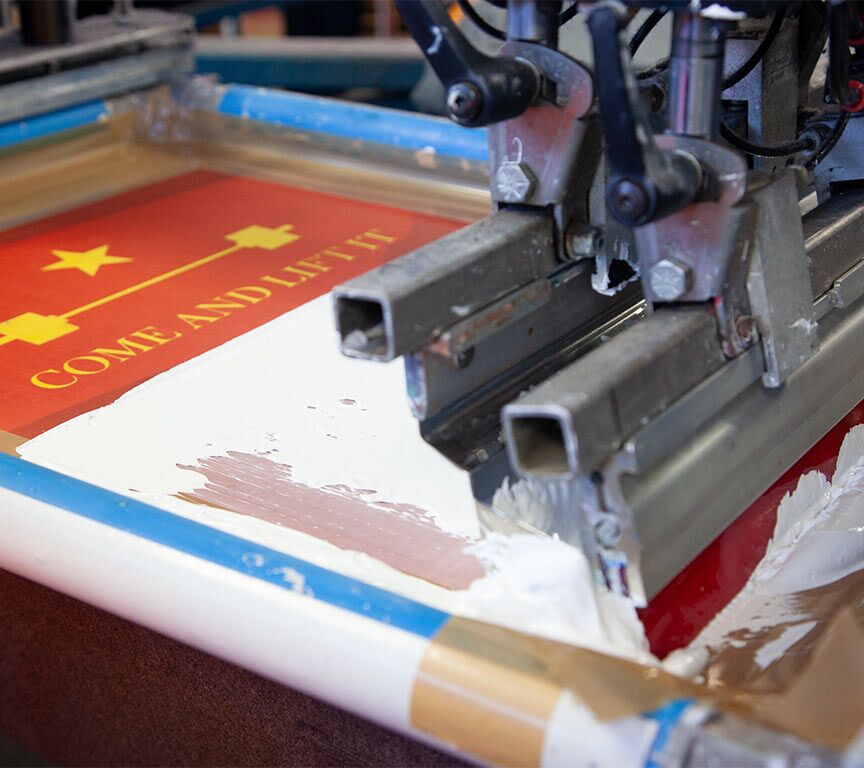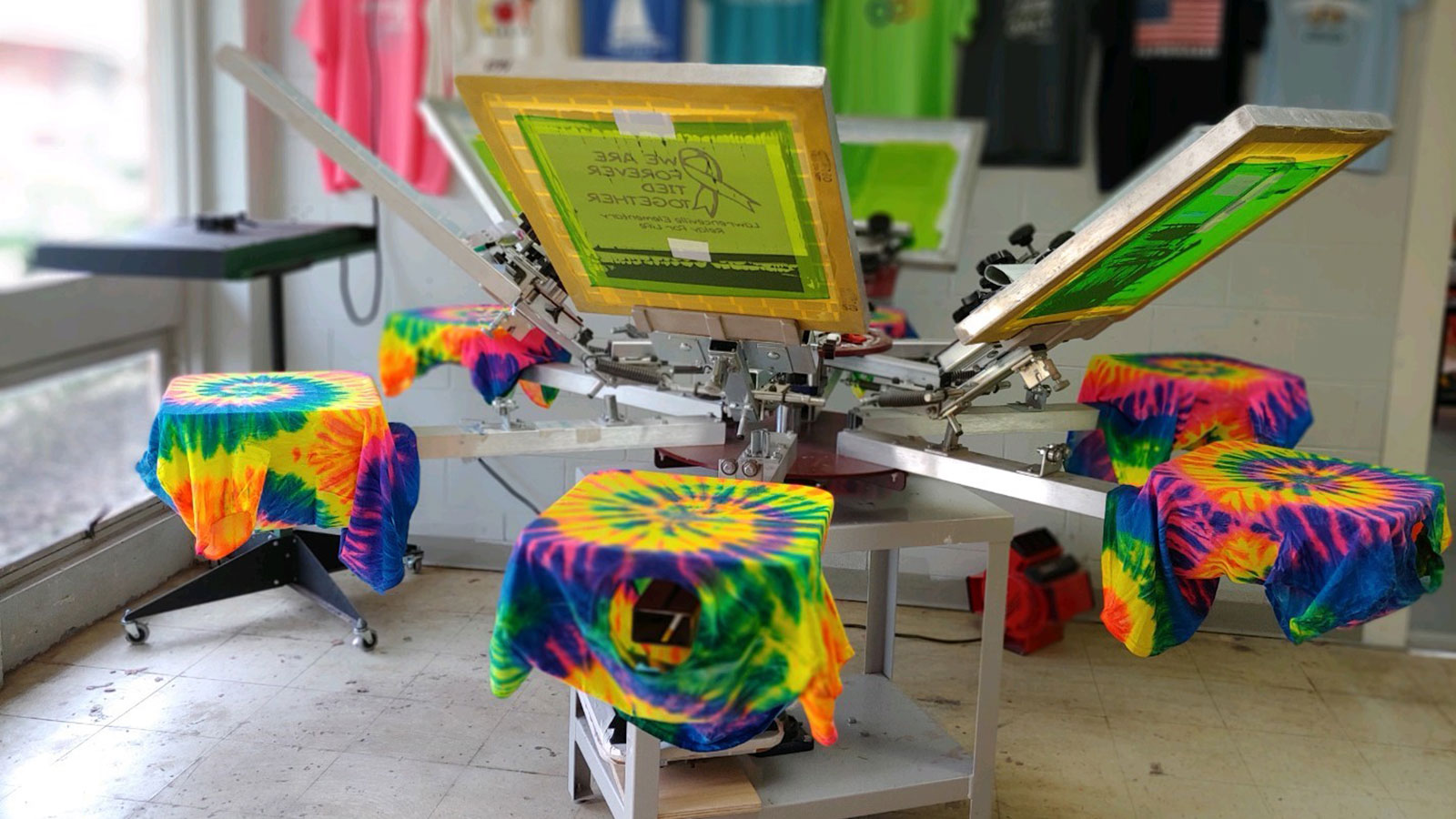Fast Turnaround Custom Screen Printing for Events
Fast Turnaround Custom Screen Printing for Events
Blog Article
Screen Printing Uncovered: Whatever You Required to Find Out About Tee and Garment Printing Strategies
If you've ever before questioned just how those dynamic designs wind up on your favored tee shirts, you're in the right location. Screen printing is a remarkable technique that combines art with method, supplying endless possibilities for imagination. Understanding the basics, from equipment to ink choices, can considerably impact your results. All set to check out the crucial elements that make screen printing an art kind? Let's discover the information that can raise your tasks.
The Basics of Screen Printing: Just How It Functions
When you plunge right into display printing, you'll uncover it's both a scientific research and an art. At its core, screen printing involves creating a stencil, or screen, that permits ink to pass with just in particular locations.
Position the screen over the fabric, then use a squeegee to push ink with the screen onto the garment. Each action is essential, and mastering them will certainly boost your screen printing skills, changing basic garments right into one-of-a-kind, expressive items.
Kinds of Display Printing Strategies
Once you comprehend the essentials of screen printing, it's time to discover the different strategies that can boost your designs. One popular method is typical screen printing, where ink is pushed with a stenciled screen. This method is great for strong, vivid colors. There's water-based ink printing, which uses a softer feel and is green, but it requires a various method to curing.
If you're intending for fine details, consider discharge printing. This method removes color from the fabric, leaving a soft, vintage look. Another alternative is plastisol printing, known for its longevity and brilliant shades, making it a favored for several brand names. Experiment with halftone printing to develop gradient results and intricate designs. Each technique has its special charm, so don't wait to attempt them bent on find what matches your design best!
Essential Equipment for Display Printing
To accomplish sensational lead to screen printing, having the best equipment is fundamental. First, you'll need a sturdy display printing frame, which holds the mesh that moves your layout onto the garment. Next, spend in high-quality squeegees; these are important for using ink equally across the display. You'll also require an excellent exposure system to produce your displays, in addition to a washout booth for cleaning them after use. A reliable warm source, like a conveyor dryer or heat press, is important for treating your prints to assure durability. Don't forget an appropriate office, geared up with tables and storage space for your products. Protective equipment, such as masks and gloves, will maintain you risk-free from chemicals and inks. With the right tools, you'll be well on your means to generating professional-quality prints.
Choosing the Right Inks and Materials
When selecting inks and products for display printing, you require to consider the kind of ink that works best for your job. Think of fabric compatibility to assure your layouts look wonderful and last lengthy. Explore green ink options to make your printing process a lot more lasting.
Types of Display Inks
Picking the appropriate screen ink is vital for accomplishing dynamic, long lasting prints that fulfill your job's requirements. There are numerous types of display inks to check out. Specialty inks, such as metal or glow-in-the-dark, can add special effects to your styles.

Material Compatibility Considerations
Recognizing material compatibility is vital for accomplishing premium display prints, particularly given that different products react distinctly to various inks. Always check your inks on example fabric to assure they adhere correctly and maintain shade stability. Furthermore, maintain in mind that textile weight and texture can impact the last outcome, so choosing the ideal ink and material combination is essential for your project's success.
Eco-Friendly Ink Options
Environmentally friendly inks are ending up being a preferred selection for screen printers who want to decrease their environmental effect while preserving top quality. When selecting inks, think about water-based inks, which are much less dangerous and less complicated to tidy up compared to standard solvents. These inks bond well with materials, providing vivid results without hazardous chemicals. You may additionally explore eco-solvent inks that make use of fewer volatile organic substances (VOCs), making them a much safer option for both your wellness and the world.
Furthermore, look for inks made from renewable energies, such as soy or vegetable-based choices. By selecting the right inks and products, you'll not just produce spectacular designs but also add to a much more sustainable printing procedure. Make the button, and your prints will reflect your commitment to the setting!
Preparing Your Style for Display Printing

File Format Needs
To ensure your style looks vibrant and sharp on material, you'll need to pay very close attention to submit format needs for display printing. Start with vector data like AI or EPS, as they can be scaled without shedding quality. If you use raster pictures, go with high-resolution documents, such as TIFF or PNG, preferably at 300 DPI. Stay clear of utilizing JPEGs, as they can lose clearness when resized. Also, see to it your design has a clear browse this site background to stop unwanted white sides on your prints. Maintain shade modes in mind; CMYK is typical for screen printing, so transform your RGB designs as necessary - screen printing kit. By adhering to these guidelines, you'll establish your art work up for a successful print.
Color Separation Techniques
Shade splitting up is an essential step in preparing your style for screen printing, and mastering it can substantially improve your print top quality. You'll need to damage your design right into private colors, as each color needs a different screen during printing. This accuracy not only ensures exact color representation yet also improves the printing process.
Resolution and Size
Achieving the very best outcomes in screen printing starts with ensuring your design has the best resolution and size. Ideally, your artwork ought to be at least 300 DPI (dots per inch) for sharp, clear prints. If you use lower resolution, your last product could look less than professional and pixelated.
When it comes to size, consider the measurements of your print location. Style your art work to match the final print dimension, preferably producing it in the actual dimensions you'll be printing. This way, you'll avoid any kind of unforeseen scaling concerns.
Always inspect your design in both vector and raster formats. Vector graphics can be scaled without shedding top quality, making them perfect for screen printing. Preparing correctly will assure your layout looks fantastic on every garment!
Step-by-Step Display Printing Refine
Screen printing is a dynamic procedure that enables you to produce lively styles on various surfaces. To get started, you'll require a display, emulsion, and your selected ink.
Pour ink onto the display and make use of a squeegee to press the ink with the stencil onto the textile. Raise the screen thoroughly and allow the print dry. You have actually effectively screen published your layout.
Tips for Effective Screen Printing Projects
While you're diving into your display printing jobs, bear in mind that prep work is vital to success. Beginning by gathering all your materials-- inks, screens, garments, and mops. A clean work area aids stop unwanted mistakes, so clean up prior to you begin.
Following, confirm your artwork is high-resolution and correctly sized for your garment. Test additional resources your display for appropriate direct exposure and clean it completely to stay clear of smudges. When mixing your inks, adhere to the maker's standards to accomplish the ideal consistency.
During printing, use even pressure with your squeegee for consistent results. Don't rush; take your time to validate each print meets your criteria. After printing, let your garments dry totally prior to managing or packaging them.
Last but not least, always keep an example of your benefit future recommendation. In this manner, you can examine your progress and boost your strategies with time. Satisfied printing!

Often Asked Questions
How Long Does It Take to Set up a Screen Printing Work?
Setting up a screen printing work usually takes around half an hour to an hour. You'll prepare the displays, mix inks, and adjust the press. The moment varies based upon complexity and experience, so remain arranged!
Can I Print on Different Textile Enters Using the Very Same Strategy?
Yes, you can publish on different fabric types using the same technique, yet you'll need to adjust your setups and inks. Some materials absorb ink differently, so trying out guarantees the finest outcomes for each material.
What Are Usual Blunders to Avoid in Display Printing?
When screen printing, stay clear of typical blunders like using the incorrect ink, neglecting correct direct exposure times, or avoiding pre-press checks. Constantly evaluate your arrangement and keep clean screens to guarantee top quality outcomes each time.
Just How Can I Properly Clean and Preserve My Display Printing Equipment?
To properly clean and preserve your screen printing tools, you should regularly clean screens with ideal solvents, examine mops for wear, and assure all tools are kept dust-free and completely dry. Consistency protects against pricey fixings and boosts performance.
Is Display Printing Eco-friendly Contrasted to Other Methods?
Display printing can be much more eco-friendly than other methods, particularly if you use water-based inks and visit their website eco-conscious products. By selecting sustainable supplies and methods, you minimize waste and lessen your effect on the planet.
Screen Printing Uncovered: Whatever You Need to Know About T-Shirt and Garment Printing Techniques
At its core, screen printing involves developing a stencil, or display, that enables ink to pass through only in specific locations. Setting the screen over the textile, after that utilize a squeegee to push ink through the display onto the garment. One preferred technique is traditional display printing, where ink is pushed via a stenciled screen.When choosing inks and products for display printing, you need to take into account the type of ink that functions ideal for your task.
Report this page